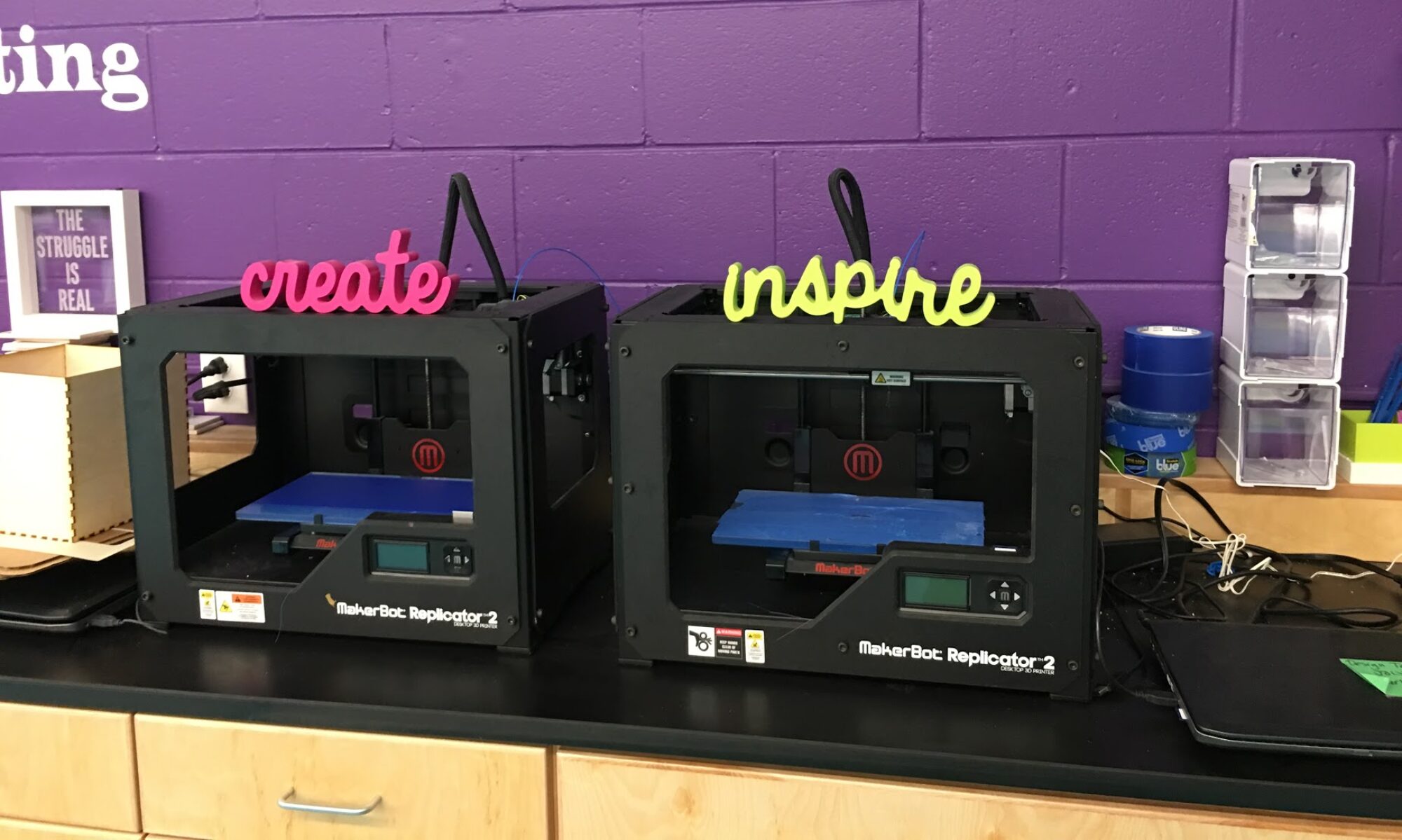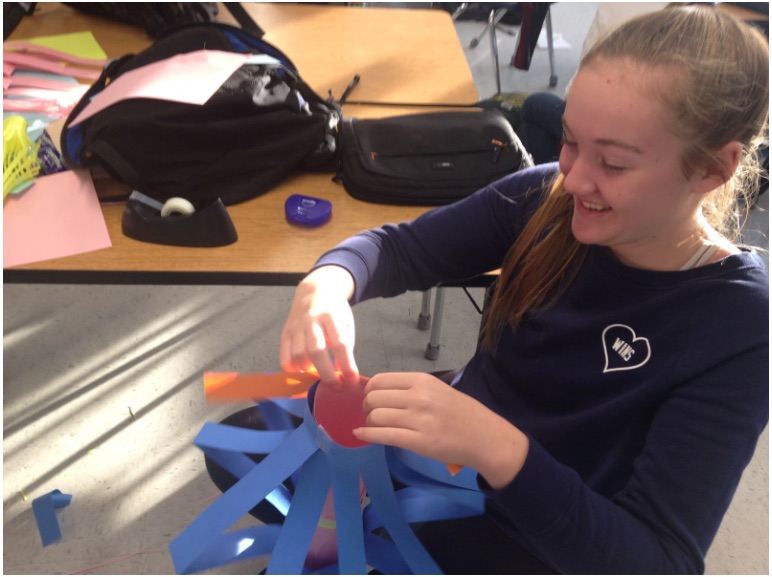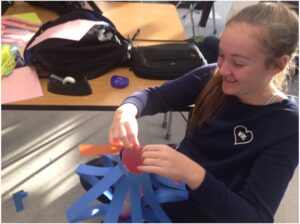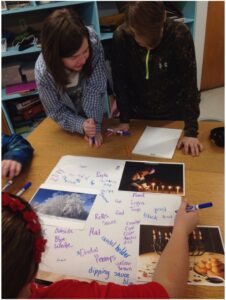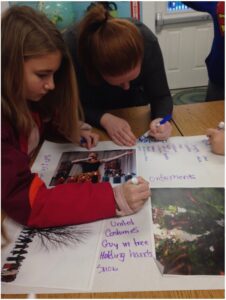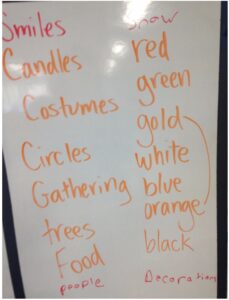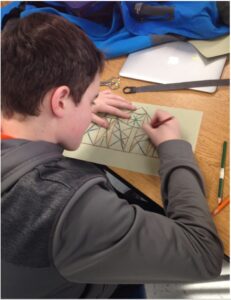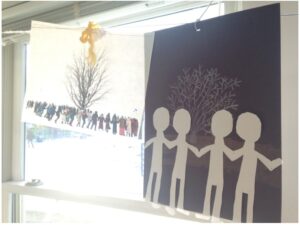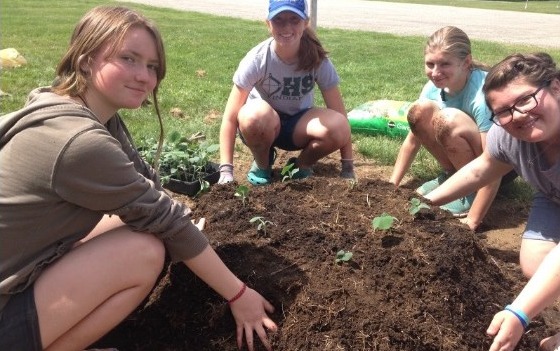Reflections from the Burke Town School
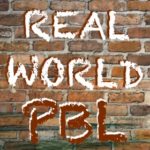 At Burke Town School, in West Burke VT, students and teachers dove into integrated project based learning (PBL) last year. Here’s what we learned.
At Burke Town School, in West Burke VT, students and teachers dove into integrated project based learning (PBL) last year. Here’s what we learned.
Building our PBL unit
This work started with an eighth grade unit, based on the United Nations Global Goals for Sustainable Development. After hearing about this work, teachers knew it would be an excellent organizer for a PBL project. They decided to build time into the school day for students to explore these Sustainable Development Goals, and build their own community service projects.
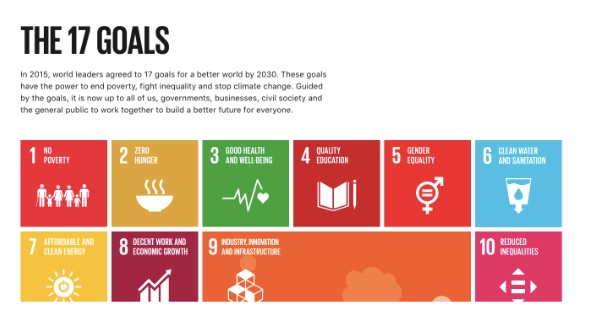
Extended planning time allowed educators to creatively deconstruct their traditional school day and work toward building student engagement.
Students showed their passion and creativity, as they dove into creating community gardens, energy committees, water wheels, community dinners, habitat restoration crews, education task forces and wilderness first aid courses.
Here’s how it worked.
In December, students participated in a community fair and several field trips to hear about what was already happening in their community. Then, they researched different goals: What did hunger look like in Burke, VT? How could students in Vermont help fight climate change?
[huge_it_slider id=”25″]
Once students found goals they would like to work on they were put into task forces (3-4 students) with classmates who had similar goals. The groups then worked together to propose projects and wrote grants to the Vermont Rural Partnership Council for funding. It was powerful for students to fund their own projects, and reach out to community members for help as they implemented projects all spring.
But what did Burke’s students think of the project?
When asked what was engaging about the project, students said:
| “I liked how we were able to choose our own project, it wasn’t something assigned to you. It was completely our own idea. It was something bigger.”
“It’s really good practice presenting, because that’s a high school skill we’ll need to work on.”
“It was very engaging because you thought of your own project, that was important to the town and to you. We were really focused.”
“Hands on, you were controlling how you were learning, and what you were learning.”
“I don’t think there was any question that was asked of me that I didn’t know the answer to.”
“I feel like this project really helped me understand my school and town b/c I had to research a lot.”
“It really does help you learn how to fail, then restart. We failed the first time, and then we got it back up, then we failed again. We realized we couldn’t overreact, and that helps make a project much better.”
“Being outside, being able to choose what we’re going to work on, being able to work with community members. Understanding our community through our goals.”
“We were able to create our own schedules, we could decide what and when to do, we made our own goals. It was more interesting”
“I liked being my own boss, we could schedule our work time.”
“It was a lot of work, with calendars and dates of field trips, our workload was more complicated because we had to problem solve with other adults, more than just our teachers.” |
As this work blossomed, there was interest in extending it to the younger grades.
Teachers wondered if we could build a continuum of transferable skills in grades 5-8, to help students build up to such a large, culminating eighth grade project. As with any good teaching, there was a need to reflect on what had gone well, and what could be improved in this PBL unit, and work to make future units better.
Teachers questioned how to better prepare students for self direction and also how to better structure time within a PBL unit, to ensure standards were addressed, students were assessed regularly, and challenged appropriately.
With these questions in mind, teachers designed a 6/7 Inquiry Unit to try out new structures in PBL learning.
Sixth and seventh grade students learned about forest ecology and also human impact on the environment. Then, they began an invention convention challenge, to build an invention that would lessen human impact. Students again worked in task forces (3-4 students) to research, build, test and improve their invention.
Here are 5 lessons learned from implementing these units.
1. Connect with the community.
A huge success of the 8th grade Projects for Hope happened at the launch of the unit. Read here about how teachers implemented a community fair to help students brainstorm project topics. The importance of community connections stayed an important part of both units. Students embraced learning from a variety of adults in their lives, and teachers leaned on community members to present content information (such as how to teach yoga or remove honeysuckle) that emerged from student projects.
Students spent a lot of time emailing and calling community partners.
This was important work, and just-in-time teaching was provided for students on how to draft professional emails, or make phone calls. Students grew in speaking and listening skills throughout this work. It was also important for teachers to design learning experiences by inviting partners in to teach lessons or lead events that the whole class could benefit from. For both units we also partnered with the local libraries (at Lyndon State College and the town library) to borrow books. Bringing in boxes of new books (fiction, nonfiction, picture books, field guides, and how to manuals) livened up the research portion of the unit. We also utilized the local Fairbanks Museum to teach field trips related to project topics.
2. Structure learning time.
One common misconception is that PBL time is free time. There is a fine balance to encouraging self direction and teaching it. Middle schoolers need structure and teachers need to ensure that there are checkpoints for learning.
A few things that helped Burke teachers ensure this time was structured:
- Common planning time for teachers
- Daily agendas
- Conferencing notes, and
- Learning scales.
Burke teachers have common planning time each day, and it was extended for half a day, once a month. This time was crucial, since teachers were integrating the unit they needed to be on the same page.
Teachers rotated who supervised what project, and therefore needed to know what had happened before, and what the end goal was. Common planning time was used to create common assessments and calendars of daily plans. These shared Google Docs allowed everyone to stay in touch, even when they were working with different groups.
For both projects, teachers were assigned small groups of students to work with. So while one teacher might supervise a whole room of eighth graders on Mondays and Wednesdays, they had one or two small groups they were working with, within that big group. While the teacher would manage the whole room and sometimes provide whole class instruction, they also had a small group to advise (ensuring that during the week each group was regularly checked in with, and had an adult point person). Advisors kept notes after meeting with their groups on a common doc, which allowed all teachers to know what was happening in each group.
Because teachers were integrating instruction, it became important to have a structure to each day.
Teachers found that opening with a mini lesson, inspirational video, or reflection set the tone of the day. After a few minutes of independent reflection, there was time for announcements and any special plans for the day/week. Then students set a daily goal (on their PLP) and work time began. Work time often looked messy (structurally and physically) but advisors checked in with their groups. At the end of the time students were responsible for uploading evidence of their work to their PLP.
Teachers often found that a closing circle was a nice way to end the day. Students shared one word of the day, or a small group taking more time to share out what they’d done.
It is important to allow for reflection and evidence collection in PBL work, and teachers soon learned that ample time needed to be built into the schedule for this. Reflection can’t be done while students are packing up, it needs to be intentional. However, it can happen in varied ways, and as the unit went on students fluctuated between teacher created reflection templates to platforms such as FlipGrid, photo evidence, Instagram posts, written reflection, etc.
3. Team-building is key
This type of PBL work requires students to communicate in small groups often. While students received individual assessments on project standards, they needed to work with others, often for extend periods of time, to make this happen. Teachers addressed this by beginning both units with ample team building (both within the middle school, the eighth grade, and the 6/7 group).
We pre-taught communication strategies and the stages groups go through (forming, storming, norming) through games and simulations.
Then, as students began their project work, advisors pointed out to students when they thought they were in a certain stage (and helped them communicate through difficult times). It became important for team-building work to happen within the small task forces (as well as the larger middle school) so that students could work together well. As with any group work there were challenges. But teachers saw students have great outcomes, many times among peers they wouldn’t have usually worked with, which is hopefully working toward a stronger school community.
4. Use best teaching practices you already know!
An important learning for our team was that PBL does not mean you have to learn a new way of teaching.
You can use many of the best practices already present in your classroom to encourage student learning in PBL. For example, teachers integrated Lucy Calkins Writing Units of Study into the PBL project by changing the topic of the 8th grade argument writing unit. Instead of writing about the same topic, students researched their representatives and wrote letters (that they actually mailed) arguing for support of their global goal. Here is a letter received back by and eighth grade student:
In addition to integrating existing curriculums, teachers also realized it was possible to find authenticity in other everyday teaching practices. Advisors conferenced with students much as you would in a reading workshop (looking over the PLP, noting celebrations, and giving students a concrete next step). We also used common assessments and kept students accountable to their learning through common learning scales.
Teachers also used community partners and their own expertise to teach.
To start the 6/7 unit students went through stations for the first few weeks – STEM teachers taught forest ecology, Humanities teachers led research and population lessons and others led team building. In this way, we covered content standards, while allowing students to investigate choice topics and build hands-on, outdoor projects!
5. Authentic audiences increase learning.
A surprising celebration that came from these units was the amount of authentic sharing students were able to engage in. A huge celebration for teachers, parents, and students was seeing the community learn from students. Everyone (teachers and students) saw a huge improvement in student speaking skills, as they presented in front of large crowds, wrote emails, called community partners, etc.
Students shared their work with other young people in the NEK at the Vermont Rural Partnerships Spring Conference. They also shared at the Shelburne Farms Sustainable Development Conference. They encouraged teachers to try project based learning through presentations to school boards, administration teams, and at Dynamic Landscapes.
Students also shared with parents/community members at Burke’s Student Showcase Night.The evening included musical performances and a student-led community dinner as well as project showcases.
As a measure of how successful this year’s even was, it was the first year we ran out of food because so many people attended!
This project was made possible by a grant from Teaching Tolerance.
